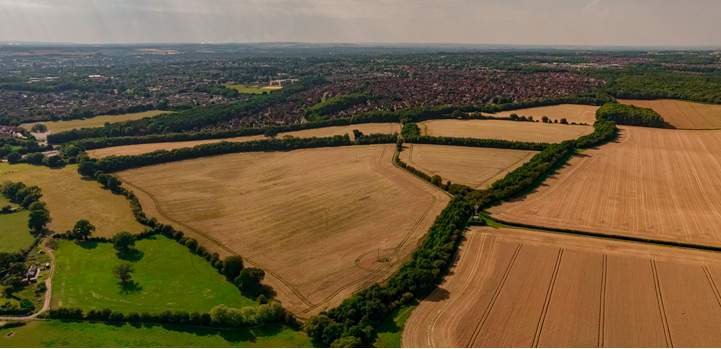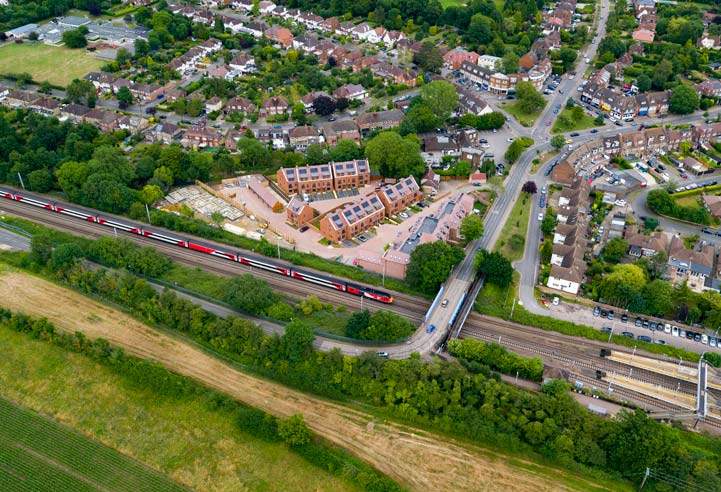Can this emerging economic powerhouse meet its housing need?
An emerging powerhouse
Hertfordshire’s buoyant housing market is a consequence of the county’s strong economic performance
Hertfordshire is part of the fastest-growing region in the UK, the Innovation Corridor, which covers the 60 miles between Cambridge and London. Due to land constraint pressures in Cambridge and around London, much of the growth in the corridor is focused in Hertfordshire, including major new development at Cheshunt, Panshanger, Rosedale Park and High Leigh.
This region is becoming a hotbed for technology, life sciences and computing. There are a mix of established global companies, such as GSK, the sixth-largest pharmaceuticals company in the world, and rapidly growing startups. The Stevenage Bioscience Catalyst offers support to the next generation of pharma and biotech companies, and in 2019 companies based there raised significant levels of venture capital funding. Achilles Therapeutics raised a £100 million Series B round and Gyroscope Therapeutics raised £50.4m. These investment rounds were the first and third largest in the UK in 2019.
Hertfordshire is becoming a hotbed for technology, life sciences and computing
Emily Williams, Associate Director, Residential Research
Life sciences are likely to become a particular driver in the demand for land in Hertfordshire in the future. The past couple of years have shown a much higher level of real estate interest in the life science sector than any time during the past 20 years. Despite the post-Brexit business and economic environment remaining an unknown, the importance of research and development (R&D) was made very clear.
The UK life sciences sector is predominantly driven by London, Cambridge and Oxford. The amount of available laboratory and R&D space in our cities is low compared to other global locations. Currently, London has c.100,000 sq ft and Manchester has 360,000 sq ft of stock compared to Boston and New York which have a combined total of 15.9m sq ft available. The delivery of more R&D workspace is vital for the UK’s growth in this sector, and Hertfordshire is well placed, in terms of both its location and economic strengths, to meet this need.
A further important sector in Hertfordshire’s economy is film and television production. The sector will be further boosted by the proposed development of a 91-acre site in Broxbourne by Sunset Studios. Around £700m will be invested in the scheme, and it is expected to create up to 4,500 new jobs. Space has also been allocated for a Media Quarter in the Hertsmere Local Plan, which will be the UK’s largest film studios complex.
Meeting the needs of a growing population
Hertfordshire’s thriving economy has seen population growth of 7.1% over the last ten years, well above the UK average. The rate of growth is projected to continue to outpace the wider UK, increasing by 10.1% by 2030. This rate of growth means that demand for land will be driven not only by commercial requirements, but also by a high level of housing need.
The Hertfordshire Growth Board has set an ambition of seeing 100,000 new homes built by 2030. In the longer term, the board has suggested building new garden communities and settlements could be part of the solution to meeting the demands of Hertfordshire. Gilston Park, a Garden Town, has been allocated for up to 10,000 homes in the East Hertfordshire Local Plan.
Infrastructure will be crucial to unlocking development. The Hertfordshire Local Enterprise Partnership has identified the three major radial corridors from London, (M1, A1(M) and M11) as areas for infrastructure driven growth, which could in turn unlock residential development. The A414 corridor will also be a major growth area, with 50% of the homes currently planned for Hertfordshire to be delivered in this area. Hertfordshire County Council is developing a transport strategy for this area, including a Hertfordshire to Essex Rapid Transit project, running from Hemel Hempstead to Stansted Airport.
The affordability challenge
Unsurprisingly, this strong economic performance has resulted in a buoyant housing market. Hertfordshire local authorities have seen house price growth far outstripping the regional and national average since 2007/08. House prices in the area have grown by an average of 57% since the global financial crisis, compared to the East of England average of 45%. St Albans has been the best performing location with growth of 63%.
The pattern of growth over the last ten years has not been uniform. The fastest period of growth was between 2014 and 2017, aided by a more stable national economy and government support for the housing market, including Help to Buy. From 2017, house price growth slowed, and in some places saw falls, in part due to mounting affordability pressures and political uncertainty over Brexit. However, the Covid-19 pandemic has changed buyer priorities, and boosted the market as buyers looked for more space, gardens, and were less constrained by their employment location.
Annual house price growth in Hertfordshire has averaged 4.6%, with Watford and North Hertfordshire the best performing local authorities with price rises of 6%. Stevenage is now the only Hertfordshire local authority where the average house price is below the East of England and national average. St Albans, Three Rivers and Hertsmere all have an average house price of over £600,000.
These figures show the strength of the Hertfordshire market, but also highlight one of the main risks to the area’s future success. Affordability pressures are an increasing problem. Only Stevenage has a median income to median house price ratio below the England average. In St Albans and Three Rivers, median house prices are over 16 times median incomes, among the highest of any local authorities outside London. This could hinder economic growth, as affordability pressures will prevent employers from attracting the workforce needed to deliver the area’s potential.
Delivering the homes Hertfordshire needs
Local authorities are struggling to meet the county’s housing needs
Where is the market opportunity?
Hertfordshire is a county with a pressing need to deliver new housing. Nearly 40,000 homes are required over the next five years according to the standard method for calculating housing need. While no local authority is currently meeting housing need in Hertfordshire, there are a wide range of delivery rates being achieved across the county.
Hertsmere and East Hertfordshire are currently the only local authorities delivering new housing at a faster rate than the England average. Their annual delivery rate of 1.3% and 1.2% of stock respectively is the highest across Hertfordshire over the three years to March 2020. In fact, housing in these local authorities is being added twice as fast as the likes of Stevenage and North Hertfordshire at 0.6% and 0.5%.
Hertfordshire has relied heavily on Hertsmere and East Hertfordshire to support overall delivery. In the past three years, the two local authorities have contributed 32% of the region’s new homes. The county will require a greater contribution from all of its local authorities in order to meet housing need. The Housing Delivery Test may provide a mechanism to boost delivery rates. Six local authorities are currently charged with presumption in favour of sustainable development and face losing some control over planning decisions given their historic record of undersupply.
Where is the planning opportunity?
To meet the housing needs of Hertfordshire’s growing population there is an increasing pressure to identify enough land for residential development. Our analysis suggests that six authorities, North Hertfordshire, St Albans, Three Rivers, Welwyn Hatfield, Hertsmere and Dacorum have not identified enough land for development to meet need.
As well as lacking a Five Year Housing Land Supply, North Hertfordshire, St Albans and Three Rivers all face the presumption in favour of sustainable development. This means there are immediate opportunities for landowners in these locations to move their sites through the planning system while the balance is tilted in their favour.

There are also multiple longer-term opportunities to bring land forward for future development. Across Hertfordshire, a number of planning authorities do not have an up to date Local Plan in place. Watford and Three Rivers are at the ‘Draft Preparation’ stage, with the potential for site allocations to be made, while Dacorum and Hertsmere currently have their Local Plans under review. There may therefore be opportunities for landowners to have their site become part of the local housing strategy.
Who is currently living in Hertfordshire?
Homes in Hertfordshire will continue to be in high demand given the economic strengths of the county and its strong connections to London. The county tends to attract affluent households searching for extra space and access to the countryside. This has only been exacerbated by the Covid-19 pandemic and the subsequent housing boom and ‘Race for Space’.
Just over two-thirds of Hertfordshire residents belong to two household demographic groups. Prestige Positions are highly educated, affluent families who typically live in spacious four- or five-bedroom homes with lots of outside space. They are the most affluent demographic group. Domestic Success are mostly couples in their 30s and 40s who usually have children and work in higher-level roles with good salaries. 10% of households in the county are Aspiring Homemakers: young people in their 20s and 30s, many of whom live on new build developments.
New homes sales
The new homes market across Hertfordshire is typically smaller than the national average. Over the last five years (to May 2021) 13% of sales across the UK were for new homes according to HM Land Registry data. Only two local authorities in Hertfordshire had a higher than average proportion of new home sales; Hertsmere (16%) and East Hertfordshire (15%). This means there remains considerable scope to increase the size of the new homes market in Hertfordshire, especially given the weight of demand for housing across the county.
Movers from London
Hertfordshire continues to be a strong draw for buyers moving out of the capital, combining space and lifestyle offers with easy journeys for commuters. Households from London made up 25.3% of those purchasing homes in Hertfordshire in 2021, according to data from Experian. That’s the second-largest buyer group behind the 55% who moved within Hertfordshire, and is up from 22.9% between 2017 and 2020. During 2021, more than a third (34%) of purchasers moving from London chose to set down roots in St Albans and Hertsmere.
Help to Buy and first-time buyers
Given the high prices and challenging deposit requirements across Hertfordshire, Help to Buy has proven to be a great advantage for first-time buyers struggling to make their first step onto the property ladder. Help to Buy has supported 50% of new home sales across Hertfordshire since March 2019, in line with the regional average of 48%.
The county’s least affordable locations such as St Albans have seen lower take-up of the scheme. Help to Buy supported 39% of new build sales in St Albans in the last two years. This is mainly because prices in these areas are still unaffordable to the majority of first-time buyers, even when using the scheme. Instead, they have been turning to more affordable locations.
In Watford and Dacorum, Help to Buy has supported nine out of ten new build sales since March 2019. The scheme is now restricted to first-time buyers and the price cap has fallen from £600,000 to £407,400 and will end for good in March 2023. A transition to First Homes and Shared Ownership may help support new build sales. That said, First Homes will only make up 25% of affordable housing provision on sites and will not be able to fill the gap left by Help to Buy on its own. Instead, developers may need to look to other tenures, including rental stock.

The role of Suburban BTR
Currently, most operational Build to Rent (BTR) homes across England are urban flats. But increasingly, suburban family homes are being delivered as rental stock. Interest in this sector continues to grow and we expect BTR delivery to ramp up in suburban locations over the next few years.
Hertfordshire is a county ripe for Suburban BTR expansion. It is a popular location for families, with over half of Savills’ new home buyers aged under 40. Many privately renting families are unable to access homeownership and are seeking to rent in suburban locations with access to local employment and good schools. Broxbourne and Stevenage have a particularly high proportion of families currently renting, at 34% and 31% of households, respectively.
Many developers are now seeking to include Build to Rent as an alternative tenure on their schemes, as it allows the delivery of their larger sites to be accelerated via the provision of an additional parcel which does not compete with, but can actually promote their private sales outlets. In a post-Help to Buy world, diversification into Suburban Build to Rent would allow developers to maintain their sales rates, de-risk their pipeline and access capital beyond traditional development finance.
